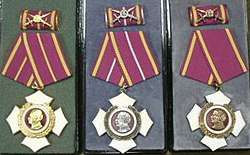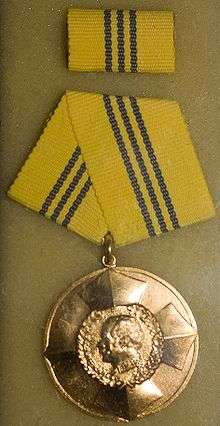Blücher Order
The Blücher Order (German: Blücher-Orden) was an order of the German Democratic Republic (GDR). It was named after the Prussian Generalfeldmarschall Gebhard Leberecht von Blücher, who was seen as a hero in the GDR for his part in defeating the invading army of Napoleon Bonaparte.
| Blücher Order Blücher Orden | |
|---|---|
 Crosses of the Order | |
| Country | |
| Type | Order |
| Awarded for | Valor in time of war |
| Status | defunct; never awarded |
| Statistics | |
| Established | 1965 |
| Related | Blücher Medal |
Ribbon bar of gold cross Ribbon bar of silver cross Ribbon bar of the bronze cross | |
History
The decoration was created in 1965 by the Chairman of the Council of State Walter Ulbricht and was supposed to be awarded to NVA soldiers as a valor award in a time of war.[1] The decoration was never awarded as the GDR was never in a state of war; however, a couple of hundred of these decorations were minted and were ready to be awarded if the GDR were at war. The decoration came in six classes: the medal grade, which was divided into three classes (bronze, silver and gold), and the cross grade, which was divided into three classes in the same way.
Some of the remaining Blücher Orders are now on display in the Military History Museum of the Bundeswehr. An example of the Gold Medal is also on display at the Canadian War Museum.
Design
The cross was shaped as a white cross; in its center there was a portrait of Gebhard Leberecht von Blücher surrounded by a wreath of oak leaves (its color was according to the class of the award). The cross was attached to a red ribbon with two yellow stripes on its edges. The silver class has a silver strip in the center and the gold class had a gold strip.
The medal was round and featured a depiction of the front of the cross on it. Its ribbon was yellow with blue stripes down its center according to the medal class.

References
- Robertson, Megan (14 January 2011). "German Democratic Republic: Blücher Order". Medals of the World. Retrieved 28 February 2011.